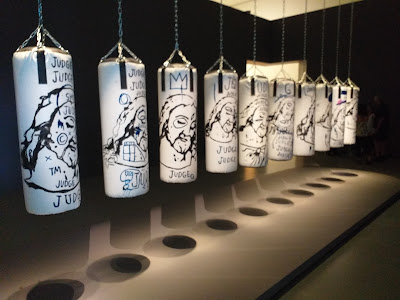 |
| Basquiat: Dos Cabezas, 1982 |
In this iconic double portrait, Basquiat shows himself, on the right, in cartoon-like mode, while Andy Warhol appears more conventional, in a characteristic 3D pose. It was painted in a couple of hours, based on a polaroid photo, taken at their formal introduction in October 1982. Warhol is recorded as commenting: "Oh I'm so jealous- he's faster than me!"
Here is the polaroid on which it was based:
In the painting, Basquiat's greens and blues harmonize with the beiges and link together the two faces. Basquiat's style is spontaneous and vivid. He captures the spirit of the older artist in another portrait, painted around the same time, when Andy regularly practised with barbells in his studio:
 |
| Basquiat: Untitled (Andy Warhol with Barbells) ca 1984 |
 |
| Basquiat: Brown Spots (Portrait of Andy Warhol as a banana) 1984 |
As for Andy Warhol's style, combining photography with silkscreen printing, his portraits of Basquiat are less humorous, sometimes referring to classical statues, like the David by Michelangelo:
 |
| Warhol: Jean-Michel Basquiat 1984 |
It was their mutual art dealer Bruno Bischofberger who brought them together, along with a third artist: Francesco Clemente. He asked the three of them to collaborate on a series of works. Bischofberger envisaged a kind of 'Exquisite Corpses' procedure, in the fashion of the Surrealists back in the 1930s, each adding his own contribution.
 |
| Jean-Michel Basquiat, Francesco Clemente, Andy Warhol: Alba's Breakfast 1984 |
Warhol contributed the General Electrics logo, while Basquiat did the graffiti and Clemente the dreamlike expressive head attached to 3 legs. A further work with a Surrealistic feeling to it is "Premonition":
 |
| Basquiat, Clemente, Warhol: Premonition 1984 |
 |
| Arm and Hammer II 1984-5 |
Thanks to Basquiat, Andy Warhol took up his brushes again, after many years of silk-screen printing. He painted a double logo of the well-known baking soda Arm and Hammer- a brand found in most American kitchens. Basquiat's imagination transforms the left-hand logo into a 'coin' with a portrait of one of his idols in the centre: Charlie Parker. The date 1955 confirms the identity- the date the jazz saxophonist died. Basquiat does something he often did to draw attention to a word- he crosses it out. Then the viewer strains to read it of course! COMMEMERITVE (sic). By juxtaposing the black musician, with 'Liberty' engraved above his head, and the 'Arm and Hammer' trademark, Basquiat creates tension and a political message.
 |
| Basquiat and Warhol: Paramount 1984 |
A complex language was created by the two artists, the themes in the above work being the cinema, capitalism, Regan's diplomatic dealings with the Chinese, combined with negro heads, a common image in Basquiat's work. Note the red and black profiles of Regan- cinema actor turned President.
 |
| Basquiat and Warhol: China 1984 |
Warhol's map of China is cut into by Basquiat's vibrant, magic figure... powerful, threatening?
 |
| Basquiat and Warhol: Taxi, 45th/Broadway 1984-5 |
To Warhol's yellow car front, Basquiat has added the drama of a scene which really happened, when a taxi driver refused to drive him. Later Basquiat said he didn't remember the incident, but the story is evident in the picture: the 'invisible' negro is being refused by the pink faced taxi driver who is cursing away! Ironically Basquiat could have amply afforded the ride; he often walked around with wads of cash on him from his painting sales and didn't have a bank account.
 |
| Basquiat and Warhol: Felix the Cat 1984-5 |
"I think those paintings we're doing together are better when you can't tell who did which parts".
An example of this might be the large panorama of African masks:
 |
| Basquiat and Warhol: African Masks ca 1984 |
 |
| Untitled (Fun Gallery Fridge) 1982 Basquiat, Keith Haring and others |
This fridge was to be seen in the Fun Gallery, founded in 1981 by Bill Sterling and Patti Astor. Their gallery quickly became one of the 'In' places of the effervescent New York scene.
Other collaborations took place naturally between fellow graffiti artists, like "A-One", alias Anthony Clark:
 |
| A-One and Basquiat: Portrait of A-One A.K.A King 1982 |
Photographer Michael Halsband took 180 pictures of the two artists, in preparation for a joint show at the Tony Shafrazi Gallery in 1985, many of which are on show here for the first time, along with one of the original posters:
 |
| Michael Halsband: Andy Warhol and Jean-Michel Basquiat New York City July 10th 1985 |
 |
Unfortunately, the 1985 exhibition was panned by the critics.
Continuing the theme of boxing, a room at the present exhibition is dedicated to a row of punch bags, kept by Warhol until his death and never before exhibited:
 |
| Basquiat and Warhol: Ten Punching Bags (Last Supper) |
Warhol painted a reproduction of the face of Christ from Leonardo da Vinci's last Supper, while Basquiat added the word JUDGE and the image he often used to indicate a hero: his three-pronged crown. The installation is chilling, evoking various emotions of frustration, inequality and suffering.
When in 1987 Andy Warhol died suddenly, aged 58, after a supposedly benign operation, Basquiat was devastated. He expressed his grief in a work he called "Gravestone":
 |
| Jean-Michel Basquiat: Gravestone 1987 |
His triptych was assembled from a door and other salvaged material. The imagery reminds us of Warhol's Cross Series of the 80s and a famous 1963 photo of Warhol holding a flower, while Basquiat's white skull, resembles in caricatural way Warhol, with a tuft of blond hair. The word 'Perishable' underlines the fragility of life. Basquiat died the following year, aged only 27.
 |
| Basquiat and Warhol: Third Eye 1984-85 |
The Louis Vuitton Exhibition illustrates an important moment in the history of New York artists and a very special collaboration between two of its prominent figures.
Basquiat X Warhol. Painting Four Hands
Until 28th August, 2023
At Fondation Louis Vuitton,
8 avenue du Mahatma Gandhi,
75116, Paris
****************


Comments
Post a Comment